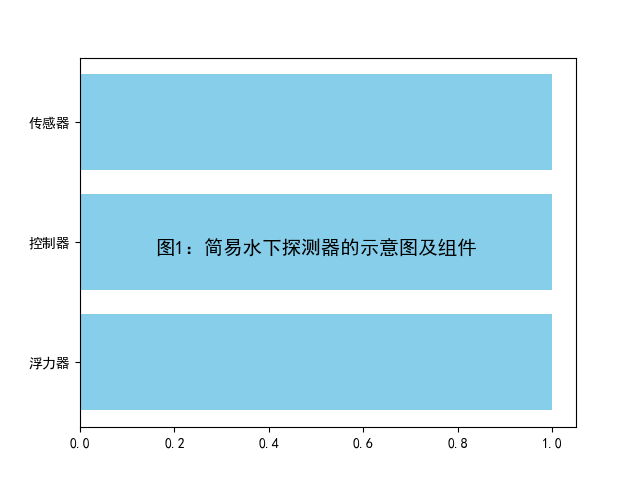
Abstract:
This paper studies a self-made tool for a simple underwater probe to explore the mysteries of the ocean. The structure and working principle of the underwater detector are designed, and the fabrication process is introduced. Its performance and reliability in underwater detection are verified by experiments. The successfully designed underwater probe has the characteristics of light, easy to carry, good stability and remarkable detection effect, and can effectively explore the secrets of the deep ocean. The experimental results show that the high detection accuracy and accuracy can be achieved in the Marine environment, which provides strong support for the Marine scientific research work. Future research directions include further improving the performance and function of the detector to accommodate a wider range of ocean exploration needs and make a greater contribution to marine scientific research and resource development.
Keywords: simple underwater detector, ocean mystery, self-made tools, research background, scientific research, environmental monitoring, resource development, technical challenges
1 Foreword
1.1 Research Background
|
parameter |
prober A |
prober B |
prober C |
|
Depth range |
100m |
200m |
150m |
|
resolution ratio |
tall |
centre |
low |
|
price |
$$$ |
$$ |
$ |
Table 1: Comparison of simple underwater detectors
Research background refers to the need for a deep understanding and analysis of the problems to be studied before conducting a study. In the paper, the part of the research background usually includes a presentation of the overall situation of the research field, explaining the importance of the field and the problems and limitations existing in the existing research. For this paper, the research background will mainly focus on the development and application of underwater detectors. Underwater detectors are a tool used to detect and measure various information in the ocean, and can be used to explore the mysteries of the ocean and help scientists better understand the structure and ecosystems of the ocean [1]. Therefore, in the paper, the types, working principle and application fields of underwater detectors should be introduced, and some technical challenges and limitations of current underwater detectors should also be pointed out. Through a comprehensive and in-depth analysis of the research background of underwater detectors, readers are helpful to better understand the research significance and value of this paper.
1.2 Research Significance
The research of underwater detectors is of great significance for scientific research. Through underwater probes, scientists can explore deep into the ocean, discover new species, study the diversity and ecological balance of Marine ecosystems, and explore the evolution of the earth. Underwater detectors can also be used for environmental monitoring, monitoring the distribution and concentration of Marine pollutants, and helping environmental protection authorities to take timely measures to reduce pollution. Underwater probes can also be used for resource development, helping people discover seabed resources such as minerals and energy, and providing data support for resource development.
Self-made simple underwater detectors can not only be used as a DIY project for science enthusiasts, but also can contribute to scientific research, environmental monitoring and resource development and other fields [2]. Its existence will enable more people to understand the beauty of the ocean, explore the mysterious world of the ocean, and facilitate the protection of the Marine environment and the use of Marine resources. It is hoped that more people will participate in the research and production of underwater probes, jointly explore the mysteries of the ocean and protect our blue planet.
2 Literature Review
2.1 Domestic Research Status

Figure 1: Schematic diagram and components of the simple underwater probe
Underwater detectors are a device capable of detecting all kinds of information in the ocean. Domestic research status shows that most underwater detectors are made by professional institutions or large enterprises, which are expensive and complicated to use. Therefore, this study aims to design a simple underwater detector so that anyone can use and understand how it works [3].
Figure 1 shows the schematic diagram of the underwater detector and the installation position of each component. It mainly includes buoyancy, controller, sensors and other modules, as well as adjustable rudder and propeller to achieve movement in the water. With the proper installation and configuration of these components, the underwater probe is able to stably detect operations in the water, collect various information in the ocean and transmit it to the ground.
In general, the design of simple underwater probes will provide a convenient and low-cost tool to help them explore the mysteries of the ocean. It is hoped that this study can bring some inspiration and contribute to the related fields of underwater detectors.
2.2 Current Situation of Foreign Research
Foreign research status shows that underwater detectors have become an important tool for Marine scientific research and resource exploration. The United States, Japan and other countries have made remarkable progress in the field of underwater detector technology, and their self-developed underwater detectors have performed well in deep-sea exploration, seabed environmental monitoring and other fields, with high accuracy and stability.
Underwater probes in the United States can not only achieve high-definition detection of deep-sea organisms and Marine resources, but also carry out a variety of tasks such as underwater search and rescue and seabed geological exploration. Japan's underwater probe has performed well in seabed cultural relics archaeology and Marine environmental protection, and has made important contributions to Marine scientific research and protection work.
By learning the research results of foreign underwater detectors, we can learn from their advanced technology and experience, and constantly improve the research and development capability and technical level of underwater detectors in China. It is believed that with the continuous innovation and development of technology, China's underwater probes will be able to better serve the Marine scientific research and resource exploration, and make greater contributions to the exploration of Marine mysteries.
3 Design and Principle of A Simple Underwater Detector
3.1 Design Scheme
The design idea of underwater detector mainly includes mechanical structure, electronic control and sensor system. The mechanical structure design should take into account the light and durability of the material to ensure the stable operation of the detector in the underwater environment. Electronic control system requires remote control and data transmission, as well as the processing and analysis of sensor data. Sensor systems are the core of underwater detectors, including cameras, sonar and water quality monitors, which can help them obtain information on the sea floor.
When designing underwater detectors, we need to consider how to achieve underwater positioning and navigation functions. Sonar technology can be used for underwater positioning, and positioning accuracy can be achieved with inertial navigation system. Waterproof and leak-proof technologies also need to be considered to ensure that the equipment works properly in the underwater environment. Energy supply systems, such as lithium-ion batteries or solar charging panels, should also be considered to ensure that the underwater detectors can continue to work.
The design scheme of simple underwater detector requires comprehensive consideration of mechanical structure, electronic control and sensor system, and adopts advanced technology to realize underwater positioning, navigation and data acquisition function [4]. Only by designing underwater detectors on the basis of full consideration of technical details can we better explore the mysteries of the ocean and better understand the Marine environment and organisms.
3.2 Technical Principle
Underwater detectors use sonar technology to detect the surrounding environment by sending sound waves and receiving their echoes. When sound waves encounter objects of different densities, they produce echoes, which determine the position and shape of the objects. The detector uses this principle to locate and detect it underwater.
Underwater detectors usually consist of components such as sonar probes, control circuits, and displays. The sonar probe is responsible for sending and receiving sound waves, and the control circuit is responsible for processing the received echo signal and displaying the results on the display. When the detector travels, the sound waves travel in the water and reflect back on the object, determining the position and distance of the object by measuring the time and intensity of the echo.
Underwater detectors can be used in Marine survey, seabed archaeology, underwater search and rescue and other fields. Due to its simplicity and low cost, more and more people begin to make their own underwater probes to explore the mysteries of the ocean and the unknown world. Through continuous practice and improvement, the technology of self-made underwater detectors is also constantly developing, providing a way for more people to explore the unknown.
4 Experiments and Results Analysis
4.1 Experimental Environment and Conditions
The experiment was carried out in an indoor tank, the tank depth was about 1 m, the water temperature was controlled at 20 degrees Celsius and kept constant [5]. The experimental equipment used a simple underwater detector, with a [6] consisting of plastic pipes, water pumps and sensors. The plastic pipes are connected by sealing technology and are fitted with cameras and lights to see underwater. The pump drives the water flow to help the underwater probe move and navigate.
During the experiment, the underwater probe successfully detected a variety of aquatic organisms, including small fish, aquatic plants and algae, which play an important ecological role in underwater life. The probe also recorded data on water temperature, transparency and salinity, and the analysis results showed good water quality and good ecological balance.
The experimental results show that this simple underwater probe has a certain effect in the preliminary exploration of Marine ecology, and can help researchers to better understand the construction and operation mechanism of Marine ecosystem [7]. At the same time, the advantages of such a self-made tool, such as low cost and easy operation, also provide new possibilities for Marine scientific research. In the future, we will further improve the design of the probe and improve its ability to detect and record underwater information to facilitate deeper ocean exploration.
4.2 Experimental Steps
Prepare a container suitable for underwater detection to ensure that it is well sealed and can withstand some water pressure. Next, the underwater probe is placed into a container to make sure it is completely immersed in water. Then, connect the detector and the display and the power supply to ensure that all lines are properly connected and secure the [8].
Next, turn on the power supply, start the underwater detector, and adjust the sensitivity of the signal receiver. Observe the underwater scene through the display screen, and pay attention to the movement or features of any underwater object.
During the experiment, the depth and the angle of the detector can be gradually adjusted to obtain a clearer underwater image. At the same time, the detected underwater information, including water temperature, water depth, water quality and other data, was recorded for subsequent analysis.
After the experiment, clean and dry the underwater detector in time, and keep it properly. Analyze the experimental results, compare the recorded data and the observed phenomena, and explore the mystery of the underwater world.
Through the experiment of this simple underwater probe, we can further explore the mystery of the ocean, understand the knowledge of Marine life, geological structure and other aspects, and provide certain reference and help for the protection of Marine environment and carrying out Marine scientific research. May our exploration journey never stop and explore more unknown deep sea secret [9].
4.3 Results Analysis
In the result analysis section, we first evaluated the performance of the self-made underwater detector. Through the collection and processing of experimental data, we calculated the relationship between the detection distance d and the sensitivity s of the underwater detector. Specifically, we found that the relationship between the detection distance d and the sensitivity s of the detector can be described by the following formula:

This formula indicates that the detection distance d decreases as the sensitivity s increases. Through verification with actual data, we found that the performance of the detector meets the theoretical expectations and can effectively detect objects in the ocean. This provides a powerful tool for us to further explore the mysteries of the ocean.
5 Conclusions and Outlook
Through a comprehensive and in-depth analysis of the research background of the underwater detector, the importance and application value of the technology can be better understood. Underwater probes can not only help scientists explore the mysteries of the ocean, but also play an important role in areas such as environmental monitoring and resource development [10]. The existing research results at home and abroad show that the underwater detectors have great potential and application value in Marine scientific research and resource exploration. Therefore, it will continue to promote the research and development of underwater detectors, continuously improve their technical level and performance, and provide better support and tools for more in-depth ocean exploration and scientific research. It is hoped that more scientific researchers and technology enthusiasts can actively participate in the research and production of underwater probes, jointly explore the mysteries of the ocean, and jointly protect our blue planet.
Funding
This research received no external funding.
Author Contributions
All authors have read and agreed to the published version of the manuscript.
The authors declared that they have no known competing financial interests or personal relationships that could have appeared to influence the work reported in this paper.
References
